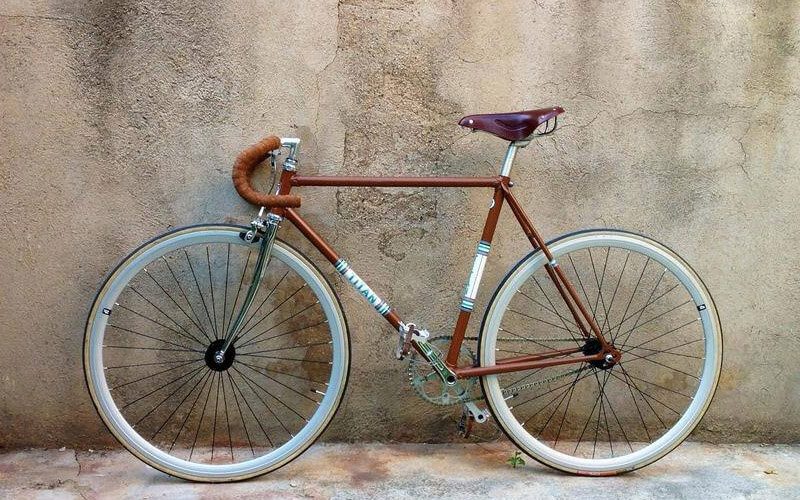Close your eyes and imagine a road bike. What are you picturing?
I’m a 90s kid who started watching cycling in 2009, so in my mind’s eye, a road bicycle is aggressively aerodynamic, made of carbon fibre and has at least one battery-powered gadget. Oh, and it’s probably black.
Personally, if I were to spend money on a bicycle, it’d have electronic shifting, deep-section rims and lightweight components. After all, why would I want anything slower, heavier and more difficult to operate?
So, when Randwick Cycling Club hosted Retro Day last weekend, I headed there with ignorance and an open mind. I wanted to find out what’s so appealing about old bicycles. Why do people bother to buy, restore, and even ride these outdated machines?
Retro Day, for those wondering, is a chance for vintage bicycle owners to showcase their pride and joy. Bikes are judged for style and presentation like prize pumpkins at the Easter Show. There’s a swap meet for aficionados to find rare parts for their next project. There’s also a retro race, where riders don iconic jerseys and put classic steeds through their paces around Heffron Park’s criterium track.
Mike Ellis: it’s history
When I arrived, the first person I ran into was my Parramatta clubmate, Mike Ellis. He showed me his 1967 Bianchi that he’d purchased from Grafton, repainted with a chrome finish and restored to ridable condition.

For Mike, his project was about celebrating history. Not in a nostalgic sense; Mike never rode these kinds of bicycles as a child. Instead, wants to preserve a physical piece of our sport’s rich past; remembering Fausto Coppi, Eddy Merckx and the like at the height of their powers.
“I was just really wanting something classic, something that I would be proud of,” Mike said. “To me, it’s like an antique that you can really look after, pass on and keep in the family. I don’t think anyone will pass on the carbon bikes; those will come and go. But this, this is something that I can be proud of.”
I’d never thought of a bicycle as an heirloom. For me, a bike is for getting about, exploring your environment, and occasionally racing as fast as you can. I’d never thought about keeping them beyond my lifetime any more than I’d contemplated preserving my 2005 iPod Nano for the grandkids (it was cool at the time, OK?).
Of course, the idea that history is embodied in objects is hardly innovative; museums have existed for millennia. For me, bicycles—especially ones that you can still ride, like Mike’s—just hadn’t fit into that mental category before. My chat with Mike was an enlightening start to Retro Day, which was about to get a little more left-of-field.
John Kitchen: it’s beauty (and insanity)
John Kitchen’s handlebars give away his eccentricity. I’m not talking about the metal things attached to his bike; it’s John’s fabulous handlebar mustache that broadcasts his passion for all things retro. A leather “hairnet” helmet and classic jersey complete the look.
He claims to own a staggering 150 bicycles. He attributes his obsession to lunacy, and it’s hard to tell if he’s being serious.
“Madness. Definitely a case of insanity,” said John when asked what motivates his extraordinary accumulation of velocipedes. “I was in the funny farm some years ago, so it could well be put down to being f—ed in the head.”

To call him a “frame builder” would be selling him well short. John Kitchen, from Bathurst, crafts all sorts of wonderful pedal-powered machines including penny farthings, 19th-century tricycles, “dandy horse” bikes, and the safety bicycle we all know and love.
John brought a sample of his collection to Retro Day, including a baby blue LeJeune on which he completed a few spirited laps of Heffron Park.
Every one of his bikes seems to have a story. The LeJeune, he told me, he bought from a drug addict desperate for cash. It originally belonged to a Tour de France rider, though it’s unclear whether or not that particular bike actually saw action in La Grande Boucle. He also owns what he believes is the oldest bicycle in Australia, an 1867 Michaux “Boneshaker” from France with wooden spokes, wooden rims and steel tyres.
For John, his appreciation of classic bikes is an aesthetic one.
“Look at the beauty in it! It’s just the most gorgeous machinery,” he said. “The modern stuff’s actually the same thing, it’s just developed, and not prettier. It’s still a double-triangle frame. It isn’t any better.”
Beauty is in the eye of the beholder: I quite like the aggressive, space-age profile of modern race bikes. They scream speed, which is usually what I’m after. But going fast all the time is not everyone’s cup of tea, and John’s love of classical styling is not lost on me. His bike does look exquisite, and I wasn’t the only one to walk up to John that afternoon to tell him so.
Like a classic car or a heritage building, some old things are still pleasing to the eye. Not every bike is to everyone’s tastes, but whether it’s a classy Colnago, a celeste Specialissima or a bright neon 70s thing, to many people, it seems a good-looking bike from any era is a sight to savour.
Shane Mattiske: it’s simplicity
Finally, I spoke to Randwick Cycling Club member Shane Mattiske, the event director of Retro Day 2019. Retro Day, he said, began two years ago as a fun day out for non-racers. While Randwick is a known racing club, many of its members join for the social side of it.
Just as it was for Mike Ellis, for Shane nostalgia is not the driving force for owning a vintage bike. It goes deeper than that; it’s about celebrating the humble bicycle without any bells and whistles.
“I think there’s certainly a lot of people who appreciate these as bikes they lusted after, or [ridden by] famous riders they followed when they were younger,” said Shane. “But there’s also a whole group of people that just really enjoy the simplicity and beauty of a steel bike, without all the complexities of fancy gear systems.”
“These are very simple, but it makes you focus more on the beauty of simply riding, rather than how expensive the carbon wheels are, or whether you’ve got Di2 or 12×1 gear systems.”

Upon asking Shane about his retro bike—a 1983 Colnago—it became evident that by “simplicity”, he didn’t mean a lack of detail. He promptly waxed lyrical about the history of Campagnolo Cobalto brakes, a type of caliper brake decorated by a distinctive blue jewel. I suppose, like any cyclist, ask a vintage bike owner about their machine and they can go on for longer than a pre-season stage race in the Arabian Desert.
For Shane, retro bikes remind us that cycling—like life in general—is not always about performance. That resonates with me. As a decidedly average B-grade club racer, it would be sad if performance was my sole yardstick. As much as I enjoy racing, I also enjoy the basic act of riding a bike; taking my (non-vintage) steel town bike to the shops, going for a leisurely spin along the river, or trundling along on the club coffee ride.
I suppose retro bikes take after the Marie Kondo school of thought. Cliche as it is, they remind us of the joy of simplicity.
Conclusion
The constant refrain of Retro Day was that the bikes of today aren’t much different to the bikes of yesteryear.
“I don’t think the bicycle has changed much in over 100 years,” said Mike Ellis. “It’s still basically the same, even the carbon bikes we have now. It’s exactly the same except for the material it’s made from.”
Two triangles, two wheels, two pedals, a chain and some handlebars; that’s been the basis of our sport for over a century. It’s not changing anytime soon, and it serves us well to remember where we’ve come from.
After spending an afternoon at Retro Day, I can see the appeal of owning an old bike. To be honest, it’s still not for me, personally. Right now, as a race-oriented millennial, I’d still reach for the carbon frame instead of the downtube shifters. But who knows? Perhaps in years to come, I, too, will yearn for something simple, beautiful and timeless.

